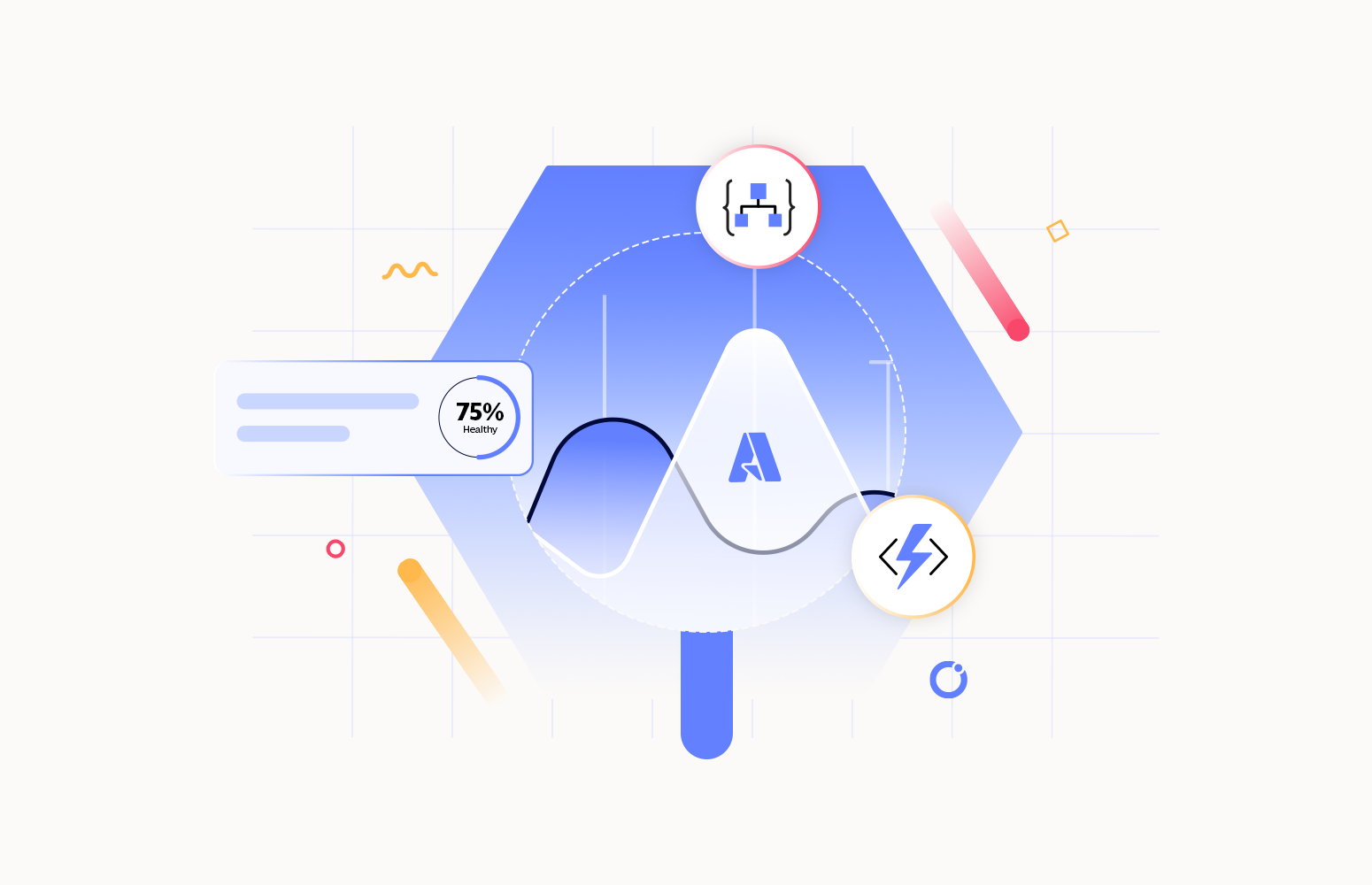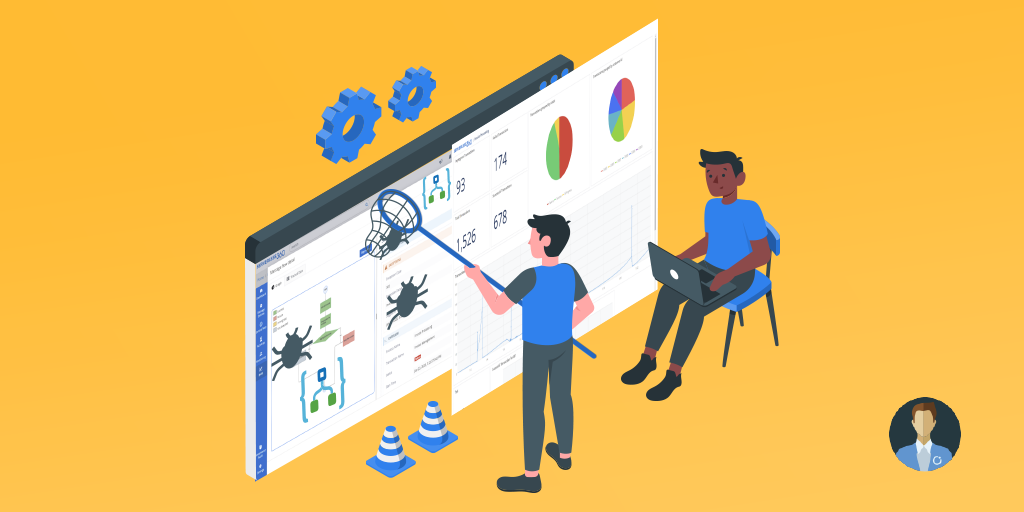Distributed Tracing, combined with end-to-end monitoring, lets organizations keep track of their business transactions and receive alerts when anomalies happen. End-to-end monitoring benefits business users and functional administrators more than developers and technical administrators.
Nowadays, for developing integration solutions, microservice architectures are becoming the norm. A solution based on such an architecture relies on different services that shape a specific solution together.

In the image above, several microservices is used to accomplish a specific business objective. The solution consists of a Web Application, a Service Bus Queue, a Topic, a Logic App, and a Function App. From a technical and functional administration standpoint, it is hard to maintain the visibility of such a distributed solution. Such challenges include:
- Operational overhead – All those microservices use different technologies and might exist in multiple Azure subscriptions and data centers. This adds complexity and makes it hard to have a good overview of the components that shape the complete solution, leading to operational overhead.
- Relationships between the microservices are difficult to comprehend – Without having an architecture diagram, it is hard to understand how all microservices relate to each other. This makes supporting such a microservices-based solution hard.
- Monitoring and troubleshooting are challenging – With all those independently running microservices, it can be challenging to find the root cause of any issues that are happening.
If for reasons like those mentioned above, you want to keep track of what is happening with your microservices-based solutions, you can set up Azure distributed tracing.
What does it take to benefit from Azure Distributed Tracing and End-to-End Monitoring?
To set up Azure distributed tracing for your microservices-based solution, you need to think of, among other things:
- Instrumentation – To collect metrics from your microservices, you need to add instrumentation to those microservices. Depending on the service, instrumentation can be done with custom code, REST API Calls, Logic App actions, etc.
- Configuration – To make sense of the collected metrics, you want to provide metadata. Think of information about the kind of (business) process at hand, but you can also configure what metrics should be picked up from the microservice, whether messages must be archived, etc.
- Visualization – A portal must visualize the collected metrics to its users. Such a portal must be easy to use and have access policies to provide (business) users access to the tracked data from the distinct solutions. The portal can be used for daily queries, analysis, and troubleshooting.
- Monitoring – The ability to have automated monitoring capabilities enables you to be aware of any anomalies. This can range from overall exception monitoring to monitoring flows that involve specific microservices.
Read more
Keep the overview of microservice-based solutions with Turbo360
Our Turbo360 product has many features that help customers to keep their microservice-based solutions healthy. The product’s feature set ranges from monitoring those microservices to being able to diagnose and act on any issues. At a high level, Turbo360 consists of the following main areas:
- Business Applications – Bundle your microservices solutions into so-called ‘Business Applications’ and manage and monitor them from one portal.
- Business Activity Monitoring – Set up Distributed Tracing and provide end-to-end visibility to your business users. Monitoring comes out of the box too.
- Azure Documenter – Get reports about resource usage, costs, and security compliance. The reports can be scheduled or run ad hoc.
- Cost Analyzer – Keep track of the costs incurred by Azure. Set up monitoring against budgets or bandwidths, and optimize costs during up/downtime.
Both the Business Activity Monitoring, or BAM, and the Business Applications modules are the most appropriate to support microservices-based solutions. Here you have an overview of what those modules offer.
Visualize complex integration flows and more with Turbo360 BAM
With Turbo360 BAM, you can visually design your business processes and choose what data needs to get tracked. For instance, if you wish to see transactions related to Order processing, you need to display data such as Order numbers, quantities, client details, processing status, etc.

Viewing and querying your transactions
Once the tracing instrumentation and configuration are done, and Order transactions are collected, you can view those transactions in Turbo360’s Tracking screen. This screen enables you, for example, to query for transactions that went wrong, data-related queries like All orders from a specific customer, etc.

There is also a detailed view that shows you what stage the transaction is, any exceptions that might have occurred, and all the available contextual information about the transaction.
At a glance, this is what Turbo360 BAM has to offer:
- End-to-end visibility of business transactions.
- Graphical business process designer.
- Tracking screen with query and export capabilities.
- Error recovery with edit/resubmit options.
- Customizable dashboards.
- Fine-grained security policies.
- Governance of operations.
- Out-of-the-box monitoring capabilities.
- Extended set of Notification Channels.
- Customizable Analytics Dashboards.
Monitor your business flows and be notified of anomalies
Besides the solid interactive capabilities of Turbo360 BAM, there are equally strong monitoring capabilities. Those capabilities prevent you from manually monitoring repeatedly while still being on top of the health of your business processes.
The product’s monitoring capabilities include the following:
- Exception monitoring.
- Transaction duration monitoring.
- KPI Query monitoring.
- Extended set of notification channels.
Manage your microservices solutions with Turbo360 Business Applications.
Turbo360 Business Applications is another module within the Turbo360 suite. With this module, you can club the microservices that belong to the same integration into logical containers and manage them from there.
Next, you can set up security profiles to give anybody the permissions they need to do their job without the risk of unauthorized operations being performed. This enables you to provide any user within your organization, from first-level support engineers to CxO, with secure and audited access to the product.
In a nutshell, Turbo360 Business Applications allows you to:
- Bundle microservices into logical containers.
- Provide fine-grained user access.
- Audit all performed operations.
- Manage and monitor almost all Azure resource types.
- Use customizable health and KPI dashboards.
- Easily understand and troubleshoot any anomalies happening.
- Graphically map and understand the correlation between resources.
- Automate regular maintenance jobs.
Extend End-to-End Monitoring to Hybrid BizTalk Server Integrations.
Until now, we have seen how Turbo360, distributed tracing tool, monitors Azure Integration Services like Service Bus, Logic Apps, etc. However, organizations that started their integration journey with BizTalk Server have started adapting to Azure Serverless by adopting a hybrid approach.
This means they extend their existing integrations in BizTalk Server with endpoints in the cloud. With BizTalk Server, that can be done by leveraging its (out-of-the-box) Cloud adapters. For example, this enables you to connect Azure Logic Apps or Service Bus directly to BizTalk Server in both receive and transmit directions.
Coming from an integration background, we understand the importance of viewing the end-to-end visibility of integration transactions at Kovai. That is why we have worked hard to extend Turbo360 and enable you to visualize hybrid integrations that involve Azure Serverless and BizTalk Server.
In the screenshot below, an integration covers both Azure Serverless (1,5) and BizTalk Server (2, 3, 4) components.

With this feature, you will be able to support the following scenarios:
- Track BizTalk Server-only integrations.
- Track integrations that involve BizTalk and Azure Serverless.
- Track debate scenarios (in BizTalk ports and orchestrations).
- Track asynchronous integrations that require correlation.
- Track fan-out scenarios.
- Track failures in transactions and provide error information.
Adding your on-premises BizTalk Server integrations to your end-to-end monitoring solution hugely extends the visibility of what is happening with your business transactions. This results in better awareness of anomalies and the ability to respond to them promptly.
Conclusion
This blog has seen the challenges of end-to-end visibility of microservice-based solutions. For reasons like business continuity, it is essential to be aware of the well-being of those solutions. You can set up distributed tracing to address the challenges and ensure all the collected data is visualized in a portal.
Turbo360 offers end-to-end visibility and monitoring of business transactions that flow through your microservices. It distinguishes itself by allowing you to monitor, troubleshoot and fix any unexpected situations. Moreover, you can monitor on-premises BizTalk Server integrations and gain end-to-end insights.
If you want to monitor your business transactions closely and are looking for a monitoring and management product for your microservice-based solutions, Turbo360 might be the right fit.
If you want to know more about the product, you can check the website, discuss your challenges with our Product Consultant team during a demo, or immediately try the product. We look forward to meeting you and seeing if Turbo360 fits you and your organization.







